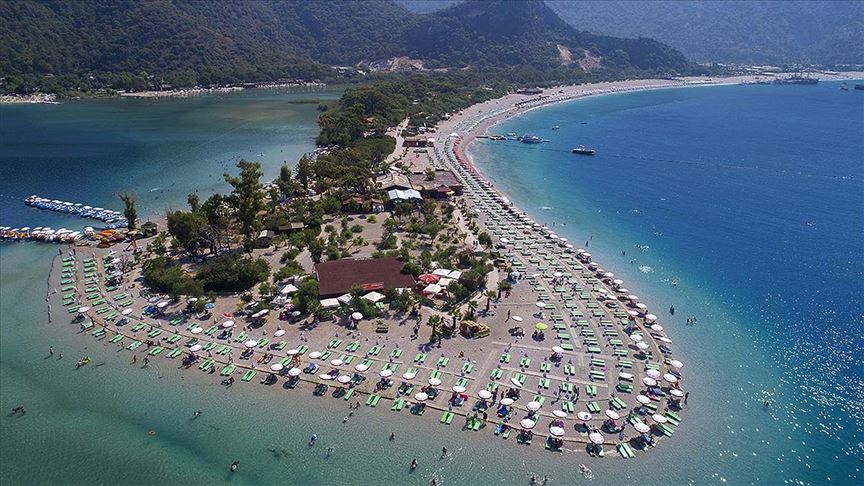While answering the question, where is Ölüdeniz, it is necessary to talk about the beauties of this place. Ölüdeniz is 14 kilometers from the city center. The first feature that stands out is that it is a quiet and restful place. Belcekiz Bay is among the most famous regions of Ölüdeniz. Contrary to popular belief, Ölüdeniz is not just a beach and a beach. There are green areas along with many beaches in the district. Adult red pine trees and holly oaks are common. The region’s daisy, poppy and marigold flowers are also famous. Oludeniz is interesting for local and foreign tourists as its natural vegetation is preserved.
Birds such as woodpeckers, partridges, owls, swallows, crows and starlings live in the forested and high areas of the district. The most common birds of prey are the hawk and hawk. Foxes and squirrels that can be seen frequently indicate that the natural life continues actively. Due to its climatic characteristics, the summer season is hot and humid. The water temperature of the coasts is about 19 – 24 degrees Celsius in different periods. Oludeniz is one of the main choices for those who want to swim, as the waters in the coastal areas are not very choppy.
In which city is Oludeniz and how to go to Oludeniz?
Turkey’s famous summer holiday resorts are around the Aegean and the Mediterranean. This place, which has the status of a neighborhood, is connected to the Fethiye district of Muğla province. The southern parts of Muğla are in the Mediterranean Region and the north is in the Aegean Region. Oludeniz has brought together the climatic features of the Mediterranean and the Aegean, which are suitable for a summer holiday.
This is one of the most visited places in Fethiye. To give a detailed answer to the question of where is Ölüdeniz; It can be said that it is located in the south of the district center and close to the Antalya border. It is easy for those who come to Muğla via Kemer or Yeşilköy to reach Ölüdeniz. Due to the location of Fethiye, Ölüdeniz is located in the middle of the coastline. Its central location reflects the urbanization level of the neighborhood.
Fethiye – What to do in Ölüdeniz?
Holiday lovers who say what to do in Ölüdeniz can come here and swim a lot. Clear waters with low algae are the distinguishing features of the region. Natural attractions nearby are worth visiting. Things to do in Fethiye Ölüdeniz can be listed as follows:
• Swimming and boat tours
Located at the junction of the Aegean and the Mediterranean, Ölüdeniz has beaches famous for its temperate waters. The four beaches that attract great attention are Ölüdeniz Beach, Kumburnu Beach, Kıdrak Beach and Belcekiz Beach, respectively. Boat tours are often made on the beach in Kıdrak Bay.
• Paragliding with a view
Babadağ is a touristic area used for paragliding in the summer. The highest point of the three-peak mountain is 1,969 meters. Those who want to watch Ölüdeniz Neighborhood, clean beaches and green areas from above can do paragliding in Babadağ. Paragliding is ideal for those who want to find an answer to the question of where is Ölüdeniz with a bird’s eye view.
• Nature walk
Fethiye is among the most natural regions of our country. You can come to Fethiye and tour the forested areas of this place. The most common region among foreign tourists is Butterfly Valley. The Valley, which has been under protection since February 1995, is the habitat of at least 70 – 80 kinds of butterflies. Those who want to go hiking can evaluate the Butterfly Valley, located at the foot of Babadağ.
A Brief Overview of Oludeniz’s History
The historical background of the region is also important. The first large community that settled in the region was the Lycians, one of the Aegean peoples. Lycian Way, stretching between Fethiye and Antalya’s Kemer district, took its name from this people. After the Lycians, the dominant powers of the region are the Persian Empire, the Alexander Empire, the Egyptian Empire, the Roman Empire and the Byzantine Empire in chronological order.
Fethiye – Ölüdeniz, which has fertile soils, is historically important. Because the Menteşeoğulları Principality captured the region in 1282 and contributed to the Turkification and Islamization of the Aegean.
